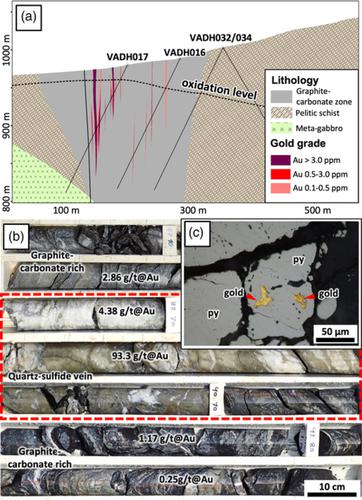当前位置:
X-MOL 学术
›
Resour. Geol.
›
论文详情
Our official English website, www.x-mol.net, welcomes your feedback! (Note: you will need to create a separate account there.)
A new orogenic gold belt in Southeast Asia: Geology, mineralogy and genesis of the Vangtat gold deposit, Southeastern Laos
Resource Geology ( IF 1.4 ) Pub Date : 2021-12-16 , DOI: 10.1111/rge.12283 Patthana Bounliyong 1 , Antonio Arribas 2 , Yasushi Watanabe 1 , Takuya Echigo 1 , Henry Wong 3
Resource Geology ( IF 1.4 ) Pub Date : 2021-12-16 , DOI: 10.1111/rge.12283 Patthana Bounliyong 1 , Antonio Arribas 2 , Yasushi Watanabe 1 , Takuya Echigo 1 , Henry Wong 3
Affiliation

|
The Vangtat deposit is the major gold deposit in a new orogenic gold belt discovered and developed in southeastern Laos in the past two decades. Our study of the Vangtat orogenic gold deposit shows that it formed within a convergent margin along the western segment of the Poko suture zone, which marks the collision between the Indochina Terrane and the Kontum Massif. Shear structure and greenschist facies metamorphic rocks are the main hosts for gold mineralization in the Vangtat deposit. High-grade gold-bearing quartz-sulfide veins and wall rock hydrothermal alteration are genetically related, and alteration minerals consist of quartz, carbonate, graphite, white mica, chlorite, and pyrite. The study of fluid inclusions and wall rock alteration assemblages indicate that the Vangtat gold deposit was formed by an aqueous-carbonic, low salinity, reduced, weakly alkaline to near-neutral pH fluid, mainly composed of H2O, NaCl, CO2, CH4, N2, H2S, H2, O2, Si, and K. Gold was predominantly carried as a sulfide complex. The precipitation of gold is related to wall rock sulfidation and the further reduction with the carbon-bearing host rock. The correlation between trapping temperature obtained from arsenopyrite geothermometry (360–395°C) and homogenization temperature obtained from primary fluid inclusion microthermometry (240–250°C), indicates a pressure and depth range for the Vangtat deposit of 380–420 MPa and 11–13 km, respectively. Gold appears as inclusions mainly in pyrite, and auriferous pyrite is homogeneous in textural, chemical, and sulfur isotopic composition. Auriferous pyrite δ34S values range from +4 to +6‰, which is compatible with the δ34S composition of igneous rocks. Together with cobalt/nickel ratios from the Vangtat auriferous pyrite, which are significantly greater than one (avg. 6.3), we suggest that mafic-ultramafic rocks in the geologic basement of the Vangtat deposit are the plausible source of hydrothermal gold and sulfur. The formation of this orogenic gold deposit is associated with metamorphic dehydration and devolatilization that transported gold to the site of deposition.
中文翻译:

东南亚新造山金带:老挝东南部万达金矿的地质、矿物学和成因
Vangtat矿床是近20年来在老挝东南部发现并开发的一条新造山金带中的主要金矿。我们对Vangtat造山带金矿的研究表明,它形成于Poko缝合带西段的收敛边缘内,标志着印度支那地块与Kontum地块的碰撞。剪切构造和绿片岩相变质岩是Vangtat矿床金成矿的主要宿主。高品位含金石英硫化物脉与围岩热液蚀变成因相关,蚀变矿物有石英、碳酸盐、石墨、白云母、绿泥石、黄铁矿等。对流体包裹体和围岩蚀变组合的研究表明,Vangtat 金矿是由含水碳质、低盐度、2 O、NaCl、CO 2、CH 4、N 2、H 2 S、H 2、O 2、Si 和 K. 金主要以硫化物络合物的形式携带。金的析出与围岩硫化和含碳母岩的进一步还原有关。毒砂地温测量法获得的圈闭温度(360-395°C)与初级流体包裹体显微温度法获得的均质化温度(240-250°C)之间的相关性表明,Vangtat 矿床的压力和深度范围为 380-420 MPa 和 11 –13 公里,分别。黄金主要以包裹体的形式出现在黄铁矿中,含金黄铁矿在结构、化学和硫同位素组成上均一。含金黄铁矿 δ 34 S 值范围为 +4 至 +6‰,与 δ 34兼容S 火成岩的组成。连同来自 Vangtat 含金黄铁矿的钴/镍比率显着大于 1(平均 6.3),我们认为 Vangtat 矿床地质基底中的镁铁质-超镁铁质岩石是热液金和硫的可能来源。这种造山带金矿床的形成与将金输送到沉积地点的变质脱水和脱挥发分有关。
更新日期:2021-12-16
中文翻译:

东南亚新造山金带:老挝东南部万达金矿的地质、矿物学和成因
Vangtat矿床是近20年来在老挝东南部发现并开发的一条新造山金带中的主要金矿。我们对Vangtat造山带金矿的研究表明,它形成于Poko缝合带西段的收敛边缘内,标志着印度支那地块与Kontum地块的碰撞。剪切构造和绿片岩相变质岩是Vangtat矿床金成矿的主要宿主。高品位含金石英硫化物脉与围岩热液蚀变成因相关,蚀变矿物有石英、碳酸盐、石墨、白云母、绿泥石、黄铁矿等。对流体包裹体和围岩蚀变组合的研究表明,Vangtat 金矿是由含水碳质、低盐度、2 O、NaCl、CO 2、CH 4、N 2、H 2 S、H 2、O 2、Si 和 K. 金主要以硫化物络合物的形式携带。金的析出与围岩硫化和含碳母岩的进一步还原有关。毒砂地温测量法获得的圈闭温度(360-395°C)与初级流体包裹体显微温度法获得的均质化温度(240-250°C)之间的相关性表明,Vangtat 矿床的压力和深度范围为 380-420 MPa 和 11 –13 公里,分别。黄金主要以包裹体的形式出现在黄铁矿中,含金黄铁矿在结构、化学和硫同位素组成上均一。含金黄铁矿 δ 34 S 值范围为 +4 至 +6‰,与 δ 34兼容S 火成岩的组成。连同来自 Vangtat 含金黄铁矿的钴/镍比率显着大于 1(平均 6.3),我们认为 Vangtat 矿床地质基底中的镁铁质-超镁铁质岩石是热液金和硫的可能来源。这种造山带金矿床的形成与将金输送到沉积地点的变质脱水和脱挥发分有关。



























 京公网安备 11010802027423号
京公网安备 11010802027423号